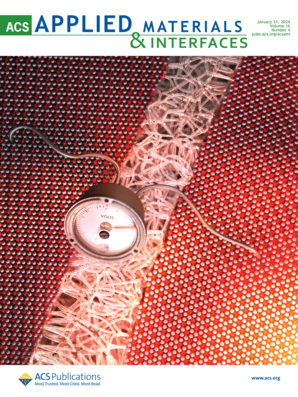Construction of Ultrafine Bimetallic Mn-Fe Phosphide Embedded in Nitrogen-Doped 3D Carbon Shells and the Excellent Na-Ion Storage Performance.
IF 8.3
2区 材料科学
Q1 MATERIALS SCIENCE, MULTIDISCIPLINARY
引用次数: 0
Abstract
Transition-metal phosphides (TMPs) possess high theoretical capacity and voltage, which make them promising candidates for anode materials in sodium-ion batteries (SIBs). However, TMP anode materials face challenges such as significant volume expansion and poor conductivity. In this study, we synthesized nanobimetallic manganese-iron phosphide (Mn1-xFexP@NC) encapsulated in hollow nitrogen-doped carbon shells using a two-step method. This structure effectively mitigates volume expansion, enhancing the cycling stability. The incorporation of manganese improves both the capacity and conductivity, allowing Mn0.11Fe0.89P@NC to achieve a specific capacity of 401.3 mAh g-1 at a current density of 1 A g-1. Ex situ X-ray diffraction (XRD) and in situ electrochemical impedance spectroscopy (EIS) techniques were used to study the sodium storage mechanism and kinetics during the discharge/charge processes. Additionally, density functional theory (DFT) calculations were performed to analyze the synergistic effect of the bimetallic system on promoting charge transfer and reaction kinetics. In a full cell with sodium vanadate phosphate as the cathode material, the battery also exhibits a high specific capacity. This study highlights the great potential of Mn1-xFexP@NC composites in enhancing the performance of sodium-ion batteries.氮掺杂三维碳壳中嵌入超细双金属Mn-Fe磷化物的构建及其优异的na离子存储性能。
过渡金属磷化物(TMPs)具有较高的理论容量和电压,是钠离子电池(sib)负极材料的理想选择。然而,TMP阳极材料面临着体积膨胀大、导电性差等挑战。在这项研究中,我们采用两步法合成了包裹在空心氮掺杂碳壳中的纳米双金属锰铁磷化物(Mn1-xFexP@NC)。这种结构有效地减轻了体积膨胀,提高了循环稳定性。锰的加入提高了容量和导电性,使Mn0.11Fe0.89P@NC在电流密度为1 a g-1的情况下达到401.3 mAh g-1的比容量。采用非原位x射线衍射(XRD)和原位电化学阻抗谱(EIS)技术研究了钠在放电/充电过程中的储存机理和动力学。此外,通过密度泛函理论(DFT)计算分析了双金属体系对促进电荷转移和反应动力学的协同效应。在以磷酸钒酸钠为正极材料的满电池中,电池也表现出较高的比容量。这项研究突出了Mn1-xFexP@NC复合材料在提高钠离子电池性能方面的巨大潜力。
本文章由计算机程序翻译,如有差异,请以英文原文为准。
求助全文
约1分钟内获得全文
求助全文
来源期刊

ACS Applied Materials & Interfaces
工程技术-材料科学:综合
CiteScore
16.00
自引率
6.30%
发文量
4978
审稿时长
1.8 months
期刊介绍:
ACS Applied Materials & Interfaces is a leading interdisciplinary journal that brings together chemists, engineers, physicists, and biologists to explore the development and utilization of newly-discovered materials and interfacial processes for specific applications. Our journal has experienced remarkable growth since its establishment in 2009, both in terms of the number of articles published and the impact of the research showcased. We are proud to foster a truly global community, with the majority of published articles originating from outside the United States, reflecting the rapid growth of applied research worldwide.
 求助内容:
求助内容: 应助结果提醒方式:
应助结果提醒方式:


